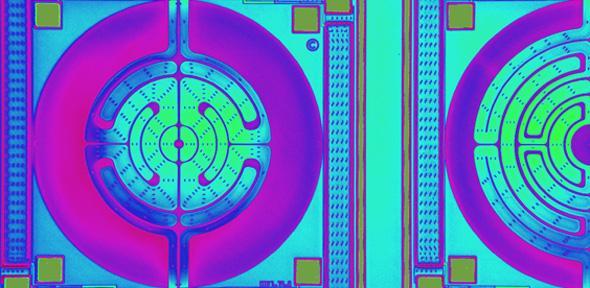
A range of diseases and conditions, from asthma to liver disease, could be diagnosed and monitored quickly and painlessly just by breathing, using gas sensing technology developed by a Cambridge spin-out.
Non-invasive breath analysis is an area of great potential for diagnosing and monitoring a wide range of medical conditions. Testing is easy and painless, and can be repeated as often as needed.
Professor Florin Udrea, Department of Engineering
The highly sensitive, low-power, low-cost infrared emitter developed by Cambridge CMOS Sensors (CCMOSS) is capable of identifying more than 35 biomarkers present in exhaled breath in concentrations as low as one part per million, and is being developed for use as a non-invasive medical testing device and other applications.
In addition to nitrogen, oxygen and carbon dioxide, we exhale thousands of chemical compounds with every breath: elevated acetone levels in the breath can indicate poorly-controlled diabetes, asthmatics will exhale higher than normal levels of nitric oxide, and glucose is a sign of kidney failure.
"Non-invasive breath analysis is an area of great potential for diagnosing and monitoring a wide range of medical conditions," said Professor Florin Udrea of the Department of Engineering and CCMOSS' CEO and co-founder. "Testing is easy and painless, and can be repeated as often as needed."
A number of breath analysis tests are currently in the research and development phase, most of which use mass spectrometry or lasers to analyse the breath for specific compounds. These tests can only detect a small range of compounds however, meaning that different devices are needed to detect different conditions.
The technology developed by CCMOSS is different in that it uses broadband infrared radiation to make the detection of a wide range of biomarkers possible in a single device. The company's miniature heaters, or microhotplates, can be heated from room temperature to 700°C in a fraction of a second, a temperature high enough to emit infrared radiation and allow the sensing material to react with gas molecules.
Many gas molecules absorb infrared. The amount of radiation absorbed allows the gas to be identified and its concentration calculated - this is the basic principle behind the roadside breathalyser test. CCMOSS' technology however, is far more sensitive. Using broadband infrared, the company's gas sensing technology can detect wavelengths between two and 14 microns, corresponding to a wide range of biomarkers. In order to detect different wavelengths, a filter is applied on top of the detector, meaning that only infrared radiation of a particular wavelength can get through.
CCMOSS' devices are based on complementary metal-oxide semiconductor (CMOS) technology, a low-power type of semiconductor which is widely used in microprocessors and battery-operated devices. Using CMOS processes results in miniaturised ultra-low power devices that can be produced at higher volume and lower cost than current state of the art gas sensing devices.
Because the CMOS process is highly reproducible, all the parameters can be very tightly controlled. The manufacturing process is highly scalable and cost effective, with yields above 99 per cent.
In addition to medical applications, the company is developing their technology for use in consumer electronics, industrial security and automotive applications. It currently has a range of products on the market and is actively involved in leading edge research and development projects for the next generation of micro and nanosensors.
The company, which spun-out from the Department of Engineering in 2009, was founded by Professors Florin Udrea and Bill Milne of Cambridge, along with Professor Julian Gardner of Warwick University. CCMOSS has been supported by seed funding from Cambridge Enterprise, the University's commercialisation arm, and was recently named Cleantech Business of the Year at the 2013 Business Weekly awards.

